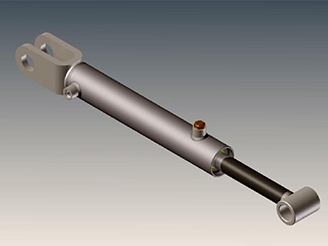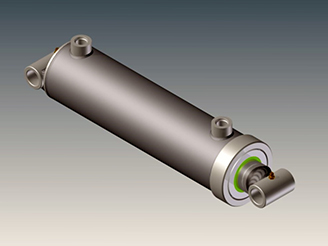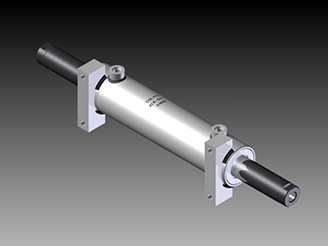If you’re looking to power your mechanical systems, hydraulics are some of the best options available. Hydraulic cylinders are widely used across mobile and industrial applications for their impressive ability to provide a significant amount of linear force.
Compared to pneumatic and electro-mechanical actuators, hydraulics cylinders offer several competitive advantages, including:
- Efficient power-to-weight ratios
- Variable speed control
- Positioning benefits
- High energy efficiencies
However, to properly take advantage of these benefits, you need to have the right cylinder. Engineering the ideal design starts with picking the right type of cylinder and then customizing it to fit your unique needs. That way, you can improve the overall performance, efficiency, and reliability of your systems.
The Different Types of Hydraulic Cylinders
Most hydraulic cylinders work around the basic premise of delivering linear force across a unidirectional stroke. Pressurized fluid from a hydraulic pump moves the piston of the device, pushing or pulling the piston rod in the desired direction.
The exact benefits that you’ll gain from your hydraulic system depend on the type of cylinder you choose.
Single Action
One of the more basic types of hydraulic cylinders, single action cylinders are made to push or pull in a  single direction. Another method – a spring, counterweight, or even gravity itself – must push the rod back to its starting point.
single direction. Another method – a spring, counterweight, or even gravity itself – must push the rod back to its starting point.
These single action hydraulic cylinders offer potential cost savings, requiring less porting and hydraulic hoses. As such, they are one of the easiest to implement in basic systems.
Apart from only pushing or pulling in one direction, the biggest downside to single acting cylinders is that you need to vent the opposing side of where you apply pressure. If you don’t have chrome ID tubing, moisture can cause rust to form on the cylinder’s internal components, and the device can go into failure.
Double Acting
For more complex operations, double acting cylinders both push and pull the cylinder’s piston for a  greater amount of linear force. Here, you apply hydraulic pressure to both sides of the cylinder, offering the typical back and forth motion associated with hydraulic power.
greater amount of linear force. Here, you apply hydraulic pressure to both sides of the cylinder, offering the typical back and forth motion associated with hydraulic power.
Most applications require the higher performance of dual action hydraulic cylinders. Machinery is often easier to operate with a double action cylinder, and it’s easier to control your system’s movement.
However, for applications that require a consistent speed and output, you can run into some trouble with normal double action cylinders. Since you’re often pumping in unequal volumes of oil on the rod side of the cylinder compared to the non-rod side, the piston will extend at a slower speed than the speed at which it retracts.
For example, if used in a power-steering application, your vehicle will be turning faster one direction than you would be in the other. If you want to stay safe on the road, that’s simply unacceptable. You would need a pump specifically designed to have a constant flow.
Double-Ended
If you have an application like the power-steering example presented above, you’ll want to do with a  double-ended cylinder. Double-ended cylinders are a type of double action cylinder with rods extending out both ends of the cylinder and equal volumes of hydraulic fluid on both sides.
double-ended cylinder. Double-ended cylinders are a type of double action cylinder with rods extending out both ends of the cylinder and equal volumes of hydraulic fluid on both sides.
These cylinders offer a standard uniform flow rate while still reaching speeds similar to those of normal double-action cylinders. With the inherent design of double-ended cylinders, there’s no need to get a specialty pump to handle something like power-steering.
Spotlight: Position Sensing Cylinders
With any of the different types of cylinders, you can add a sensor to the design for increased stroke control and programmability. Cylinders with integrated sensors are called position sensing cylinders or “smart” cylinders.
Normal cylinders simply expand or retract in response to your pressure input. By adding a sensor to your cylinder, you can sense the position of the piston at any given time.
This feedback can then go to a controller, which can adjust the movement of the piston accordingly. Over time, you can take this feedback and program your controller to have the cylinder repeat certain stroke patterns to match a precise function of your machine. You can also have your controller change the stroke of your cylinder in response to certain situations. This is especially valuable in autonomous applications, subsea environments, and with heavy mobile equipment.
Getting the Right Cylinder: How Columbus Hydraulics Can Help
Choosing the right type of cylinder for your application is just the first step. In order to maximize the performance and efficiency of your system, your cylinder needs to be further customized to meet the unique needs of your specific application.
That’s where Columbus Hydraulics can help. We have the technical expertise and custom hydraulics experience to tailor your chosen cylinder type to best fit your unique system. All standard base models are available to choose from as a starting point for your custom-engineered design.


